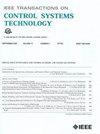Adaptive Learning Control for Time-Varying Parameter Pneumatic Artificial Muscle Robots With Force/Torque Perturbation and Input Delays
IF 3.9
2区 计算机科学
Q1 AUTOMATION & CONTROL SYSTEMS
引用次数: 0
Abstract
This article proposes a comprehensive adaptive learning controller to improve control accuracy and resist disturbance force/torques for pneumatic artificial muscles (PAMs), as well as handling various problems, e.g., time-varying parameters, unmodeled dynamics, and input delay. The modified neural networks compensate for nonlinear structures with time-varying parameters, where it is unnecessary to repeatedly calculate activation functions, reducing computational efforts. Specifically, a new integral term of input delay errors and closed-loop filter-based auxiliary signals is introduced into the designed update law and controller. When PAMs suffer from external disturbance force/torques during man–machine interaction, a modified force/torque observer is designed independently of measurement values and model knowledge (e.g., measured outputs and dynamic matrices in PAMs), to avoid sampling errors, noise, and so on. As far as we know, this is the first solution to handle time-varying parameters, resist input delay, and compensate for force/torque impacts together for PAMs, without any structure limits or a prior model information. It is proven that the tracking errors exponentially converge to zero; moreover, all closed-loop signals are uniformly ultimately bounded (UUB) when disturbance forces/torques are injected into the system. Some experimental verification is also conducted on a self-built platform.力/转矩摄动和输入延迟时变参数气动人工肌肉机器人的自适应学习控制
本文提出了一种全面的自适应学习控制器,以提高气动人工肌肉(PAMs)的控制精度和抵抗扰动力/扭矩,并处理各种问题,如时变参数、未建模动力学和输入延迟。改进后的神经网络补偿了具有时变参数的非线性结构,无需重复计算激活函数,减少了计算量。具体而言,在设计的更新律和控制器中引入了输入延迟误差和基于闭环滤波器的辅助信号的积分项。当PAMs在人机交互过程中受到外力/扭矩干扰时,设计了一个独立于测量值和模型知识(如PAMs中的测量输出和动态矩阵)的改进的力/扭矩观测器,以避免采样误差和噪声等。据我们所知,这是第一个在没有任何结构限制或先验模型信息的情况下,同时处理时变参数、抵抗输入延迟和补偿力/扭矩影响的pam的解决方案。证明了跟踪误差指数收敛于零;此外,当扰动力/转矩注入系统时,所有闭环信号均均匀最终有界(UUB)。并在自建平台上进行了实验验证。
本文章由计算机程序翻译,如有差异,请以英文原文为准。
求助全文
约1分钟内获得全文
求助全文
来源期刊

IEEE Transactions on Control Systems Technology
工程技术-工程:电子与电气
CiteScore
10.70
自引率
2.10%
发文量
218
审稿时长
6.7 months
期刊介绍:
The IEEE Transactions on Control Systems Technology publishes high quality technical papers on technological advances in control engineering. The word technology is from the Greek technologia. The modern meaning is a scientific method to achieve a practical purpose. Control Systems Technology includes all aspects of control engineering needed to implement practical control systems, from analysis and design, through simulation and hardware. A primary purpose of the IEEE Transactions on Control Systems Technology is to have an archival publication which will bridge the gap between theory and practice. Papers are published in the IEEE Transactions on Control System Technology which disclose significant new knowledge, exploratory developments, or practical applications in all aspects of technology needed to implement control systems, from analysis and design through simulation, and hardware.
 求助内容:
求助内容: 应助结果提醒方式:
应助结果提醒方式:


